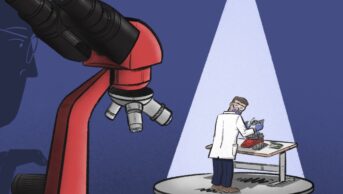
Royal Pharmaceutical Society
There are inconsistencies in the regulations surrounding controlled drugs.
Exactly which type of healthcare professional can prescribe specific drugs is open to interpretation, but it is the pharmacist dispensing these drugs who could be liable for criminal prosecution.
Laying out the law
Under the Misuse of Drugs Act 1971 (MDA), possession, production and supply, import or export of controlled drugs is totally prohibited — except under licence from the Home Secretary, or as allowed by regulations[1](ss. 3−5) including the Misuse of Drugs Regulations 2001 (MDRs)[2].
While it is illegal to supply a controlled drug under s.4 of the MDA, a pharmacist may lawfully do so in accordance with provisions in reg. 16 of the MDRs. Similarly, a patient is not guilty of the crime of possession of a controlled drug if it has been prescribed to them by an appropriate practitioner[2](reg. 10(2)).
“Appropriate practitioners” may write prescriptions for prescription-only medicines (POMs) by virtue of reg. 214 of the Human Medicines Regulations 2012 (HMRs)[3]. Doctors, dentists, supplementary prescribers (SPs), nurse independent prescribers and pharmacist independent prescribers are appropriate practitioners in relation to all POMs; while independent prescribers from healthcare professions (such as podiatrist independent prescribers) and “approved country health professionals” (that is, EU practitioners) are appropriate practitioners for certain POMs defined within the regulation.
A physiotherapist independent prescriber, for example, is an appropriate practitioner in relation to any POM, unless it contains a substance or product specified in Schedule 1, 2 or 3 of the MDRs other than dihydrocodeine; fentanyl; morphine; oxycodone; or temazepam[3](reg. 214(5B)). Schedule 1, 2 and 3 controlled drugs are designated by the HMRs as “products subject to special medical prescription”[3](reg. 213(3)).
Who can prescribe what?
Unfortunately, additional conditions for these “special medical prescriptions” are included not in the HMRs but in reg. 15 (‘Form of prescriptions’) of the MDRs. This regulation includes requirements that will be familiar to pharmacists, such as including the total quantity of the drug in both words and figures.
There are, of course, areas of overlap between medicines and drugs, but this fact is not well-served by provisions in the MDRs, which are unclear and even contradictory. For instance, controlled drugs included in reg. 214 of the HMRs are omitted from the MDRs, while other drugs are added; this creates a degree of ambiguity around who can prescribe what[4]. In the example of physiotherapist independent prescribers, the MDRs only permit them to prescribe the controlled drugs listed in reg. 214(5) of the HMRs for administration by a specified route (usually oral), plus two benzodiazepines that are not “products subject to special medical prescription.”
Regs. 6B and 6C of the MDRs specifically authorise independent prescribers — including nurses and pharmacists, and physiotherapists and podiatrists, respectively — to prescribe controlled drugs; but, surprisingly, there is no equivalent provision for doctors and dentists, or radiographers and paramedics. While doctors and dentists are permitted by custom to prescribe controlled drugs, an interpretation of the law is that physiotherapists and podiatrists are not[5–10].
This incongruity between relatively recent medicines regulations and ageing drugs legislation has been discussed at length[4]; however, there is also a significant degree of internal inconsistency within the MDRs themselves, which requires discussion and swift amendment.
Open to interpretation
Within the MDRs, the definition of a prescription states that it must be issued by a doctor, a nurse independent prescriber, a pharmacist independent prescriber, a supplementary prescriber or a dentist (reg. 2). In unequivocally stating that only those groups can write prescriptions for controlled drugs, reg. 2 of the MDRs directly contradicts reg. 6C, which explicitly authorises both physiotherapist and podiatrist independent prescribers to prescribe medicines in this category.
One may interpret this in two ways. The first: a document written by a physiotherapist or podiatrist independent prescriber, which is otherwise fully compliant with all the requirements of reg. 15 of the MDRs, would not authorise the supply of any Schedule 1, 2 or 3 controlled drugs, because “prescriptions” cannot be written by these practitioners. The authorisation in reg. 6C is therefore meaningless. Yet, current guidance from the Royal Pharmaceutical Society, the Chartered Society of Physiotherapy and the Pharmaceutical Services Negotiating Committee — among others — specifies that these groups may prescribe the controlled drugs specified in reg. 6C of the MDRs[10,11](p. 1706)[12–14].
In a second interpretation, one might determine that the definition of a prescription is invalid, in which case doctors and dentists cannot write prescriptions for controlled drugs because there is no equivalent to reg. 6C that authorises them to do so. Their authorisation to prescribe is implied by their inclusion in the definition of a prescription, which is now redundant.
At present, only nurse and pharmacist independent prescribers are authorised by each of the necessary elements — namely, reg. 214 of the HMRs and regs. 2 and 6B of the MDRs — to write prescriptions for Schedule 1, 2 and 3 controlled drugs. There would appear to be no workable solution to this that does not require a change to the definition of a prescription and/or explicit authorisation for doctors and dentists to prescribe controlled drugs as afforded to other groups by regs. 6B and 6C.
Internal inconsistencies of this kind exist throughout the MDRs. Reg. 6(2) states that any person who has in their possession a controlled drug that has been supplied against the prescription of a doctor or dentist; a registered nurse; a pharmacist independent prescriber; a physiotherapist independent prescriber; a chiropodist (not podiatrist, as specified in the HMRs) independent prescriber; or a supplementary prescriber, may supply that drug to any pharmacist for the purpose of destruction. This would appear to state that each of these groups may prescribe controlled drugs, which cannot be true as the law — however you choose to interpret it — is currently written.
Why this matters for pharmacists
Pharmacists wondering what this regulation means for them should know that poor drafting of this kind affects them — as the suppliers of controlled drugs — much more than it does those who write prescriptions for them.
The prescriber would not commit any offence in writing what they believed was a valid prescription, but both the pharmacist and the patient would commit the offences of supply and possession, respectively[1](ss. 4-5), as no lawful order would exist that fulfils the requirements of regs. 8 to 10 of the MDRs.
At present, any pharmacist dispensing a controlled drug prescription issued by either a physiotherapist or podiatrist independent prescriber (or by a doctor or dentist, depending on which interpretation they prefer) would be doing so unlawfully within the letter of the MDRs.
Given the current guidance in this area, however, it seems unlikely that either a prosecution or fitness-to-practise proceedings would be the likely outcome of doing so. Nonetheless, this leniency would be at the discretion of the Crown Prosecution Service or General Pharmaceutical Council.
Inconsistently drafted laws must change
Inconsistent and ambiguous drafting is not limited to just one area of the MDRs. As already stated, there are major inconsistencies between medicines regulations originating within the Department of Health and Social Care, and the drugs legislation arising from the Home Office, especially where these two areas of law overlap.
Elsewhere, regs. 8 and 9 of the MDRs deal with the production and supply of Schedule 2, 3, 4 and 5 controlled drugs. Rather than dealing with each of these prohibited acts for all schedules of controlled drugs within its own separate regulation, these have been organised in a way that deals with both acts simultaneously: once for drugs in Schedules 2 and 5, and again for Schedules 3 and 4. Although both deal with the same actions, there is little correlation between the two regulations. For example, persons authorised to supply Schedule 2 and 5 controlled drugs by paragraphs 2(d) and 2(da) of reg. 8 are authorised to supply Schedule 3 and 4 controlled drugs by paragraph 3(b) of reg. 9. There appears to be no reason other than indifferent drafting to explain why these regulations should not correlate.
The Misuse of Drugs Regulations in the form we currently recognise them first came into force in 1985, some 14 years after the Misuse of Drugs Act received its Royal Assent[15]. Another 16 years passed before these regulations were revoked and re-enacted, with amendments, in December 2001[2]. As the 20th anniversary of that date approaches, it is surely time to revisit these regulations with a view to ensuring that they are clear, unambiguous and compatible with all other UK laws.
Cathal Thomas Gallagher, reader in healthcare ethics and law, Department of Clinical and Pharmaceutical Sciences, University of Hertfordshire.
The views and opinions expressed in this article are those of the author and do not necessarily reflect the official position of the University of Hertfordshire.
- 1Misuse of Drugs Act 1971. London: HMSO 1971.
- 2Misuse of Drugs Regulations 2001/3998. London: HMSO 2001.
- 3Human Medicines Regulations 2012/1916. London: HMSO 2012.
- 4Gallagher CT. UK non-medical CD prescribing law: permissive or restrictive? Prescriber 2021;31:E1. doi:10.1002/psb.1900
- 5Independent prescribing and paramedics: FAQs. Health Education England. 2019.https://wessex.hee.nhs.uk/wp-content/uploads/sites/6/2020/04/PCTH-Paramedics-Paramedics-and-Independent-Prescribing-FAQ-Guide..pdf
- 6Human Medicines (Amendment) Regulations 2018/199. London: HMSO 2018.
- 7Practice guidance for radiographer independent and/or supplementary prescribers. Society and College of Radiographers. 2018.https://www.sor.org/getmedia/3086df1b-c90c-42f2-9ee9-ab34d5f07855/prescribing_practice_guidance_final.pdf_2
- 8Practice guidance for paramedic independent and supplementary prescribers. College of Paramedics. 2018.https://www.collegeofparamedics.co.uk/COP/Professional_development/Medicines_and_Independent_Prescribing/COP/ProfessionalDevelopment/Medicines_and_Independent_Prescribing.aspx?hkey=04486919-f7b8-47bd-8d84-47bfc11d821a
- 9Medicines entitlements of our registered professions. Health and Care Professions Council. 2018.https://www.hcpc-uk.org/globalassets/about-us/what-we-do/medicines-entitlements-of-our-registered-professions.pdf
- 10Who can prescribe what? Pharmaceutical Services Negotiating Committee. 2020.https://psnc.org.uk/dispensing-supply/receiving-a-prescription/who-can-prescribe-what/
- 11British National Formulary. 80th ed. London: : Royal Pharmaceutical Society 2020.
- 12Practice guidance for physiotherapist supplementary and/or independent prescribers. 4th ed. London: : Chartered Society of Physiotherapy 2018.
- 13Medicines, ethics and practice. 43rd ed. London: : Royal Pharmaceutical Society 2019.
- 14Medicines: prescribing, sale, supply and administration of medicines by podiatrists. Bridgwater: : College of Podiatry 2020.
- 15Misuse of Drugs Regulations 1985/2066. London: HMSO 1985.
You may also be interested in

What are the views of the RPS and Pharmaceutical Press on AI training using copyrighted materials?

Government should consider ways to prevent ‘inappropriate overseas prescribing’ of hormone drugs, review recommends
